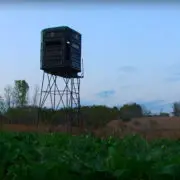Hunting Blinds | 3 Great Food Plot Locations Most Food Plotters Miss
Hard To Hunt Food Plot Locations Solved With Hunting Blinds
If you’re a deer hunter the anxiety is probably about to overtake you. Rain and sunshine are on its way, and you can’t help but get excited about putting in new food plots for deer season. Fresh turned over dirt, the tractor firing up, and a lush green mat gets even the season hunters and food plotters fired up, but hold keep a grip on that excitement for a little longer. Planning before you plant is more important than planting itself. We just recently went over the planning you should do before putting in a new food plot, touching on the importance of incorporating the plot into your hunting strategy. While this advice is key and true for installing new food plots, you shouldn’t overthink it. One of the most common reasons great food plot locations do not get planted, is there is not always a clear way to hunt it. We beg to differ, here are 3 key food plot locations that most food plotters miss, but with our help, can be great hunting locations for you.
Food Plot Architecture: Where to Place Your New Food Plot | Drury Outdoors
(Video) – DOD TV: food plots are vital to holding and killing whitetails, here are three tips for establishing new food plots.
Food Plot Location 1: Adjacent to a Bedding Area
Perhaps the best, most often missed food plot location that is not taken advantage of, are food plots adjacent to bedding areas. A small feeding plot within 50 -100 yards of a bedding area will be a perfect spot to ambush in a kill plot or staging area scenario. Why are these not planted?
Hunting opportunity and pressure are of big concern on these food plots. Finding and hunting a tree stand close enough to get a shot would be hard to get into and out of without busting deer. However, placing a ground blind or hunting blind just out of sight, or an elevated box blind distant form the plot, with the food plot still in sight, gives you a completely different scenario.
Food Plot Location 2: Adjacent To a Water Source
This may seem lame to you and your probably thinking “there is water sources next to food sources everywhere…”, and you would be right in saying that, but more often than not that water source is placed in or next to the food plot, not the other way around. Not very often do you see food plots strategically placed right on or next to a small creek, edge of a river, lake, or existing pond. Why are these not planted?

Food Plot Location 3: Travel Corridors
These are your hidey-hole food plot locations. These are commonly small staging plots before larger food plots, clearings in woods, or just simple a ridge top or bottom field where deer travel frequently. Why are these not planted?

These food plot locations are often not planted because a hunter cannot get around the thought of hunting it properly without busting deer. However if you consider more hunting possibilities with hunting blinds, ground blinds, and elevated box blinds, these food plots become not only great locations to plant but an essential part of a successful hunting strategy.

